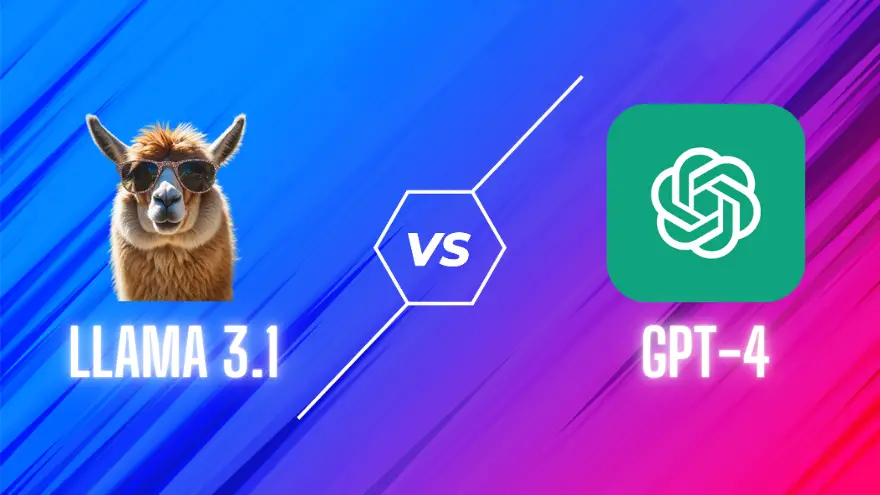We evaluated the performance of Llama 3.1 vs GPT-4 models on over 150 benchmark datasets covering a wide range of languages. Additionally, we conducted extensive human evaluations comparing Llama 3.1 to GPT-4 in real-world scenarios. Our experimental results indicate that the Llama 3.1 405B model is competitive with GPT-4 across various tasks. Furthermore, the smaller Llama 3.1 models (8B and 70B) also perform well against both closed and open models with a similar number of parameters.
Benchmark Performance: Llama 3.1 vs GPT-4
To objectively compare Llama 3.1 vs GPT-4, let’s examine some key benchmark results:
General
| Benchmark | Llama 3.1 8B | Llama 3.1 70B | Llama 3.1 405B | GPT-4 |
| MMLU (0-shot, CoT) | 73.0 | 86.0 | 88.6 | 85.4 |
| MMLU PRO (5-shot, CoT) | 48.3 | 66.4 | 73.3 | 64.8 |
| IFEval | 80.4 | 87.5 | 88.6 | 84.3 |
Code Generation
| Benchmark | Llama 3.1 8B | Llama 3.1 70B | Llama 3.1 405B | GPT-4 |
| HumanEval (0-shot) | 72.6 | 80.5 | 89.0 | 86.6 |
| MBPP EvalPlus (base) (0-shot) | 72.8 | 86.0 | 88.6 | 83.6 |
Math
| Benchmark | Llama 3.1 8B | Llama 3.1 70B | Llama 3.1 405B | GPT-4 |
| GSM8K (8-shot, CoT) | 84.5 | 95.1 | 96.8 | 94.2 |
| MATH (0-shot, CoT) | 51.9 | 68.0 | 73.8 | 64.5 |
Reasoning
| Benchmark | Llama 3.1 8B | Llama 3.1 70B | Llama 3.1 405B | GPT-4 |
| ARC Challenge (0-shot) | 83.4 | 94.8 | 96.9 | 96.4 |
| GPQA (0-shot, CoT) | 32.8 | 46.7 | 51.1 | 41.4 |
Tool use
| Benchmark | Llama 3.1 8B | Llama 3.1 70B | Llama 3.1 405B | GPT-4 |
| BFCL | 76.1 | 84.8 | 88.5 | 88.3 |
| Nexus | 38.5 | 56.7 | 58.7 | 50.3 |
Long context
| Benchmark | Llama 3.1 8B | Llama 3.1 70B | Llama 3.1 405B | GPT-4 |
| ZeroSCROLLS/QuALITY | 81.0 | 90.5 | 95.2 | 95.2 |
| InfiniteBench/En.MC | 65.1 | 78.2 | 83.4 | 72.1 |
| NIH/Multi-needle | 98.8 | 97.5 | 98.1 | 100.0 |
Multilingual
| Benchmark | Llama 3.1 8B | Llama 3.1 70B | Llama 3.1 405B | GPT-4 |
| Multilingual MGSM (0-shot) | 68.9 | 86.9 | 91.6 | 85.9 |
Overall Benchmark Analysis
The benchmark results reveal that Llama 3.1 models consistently perform at a competitive level with GPT-4. The Llama 3.1 405B model excels across various categories, often surpassing GPT-4, particularly in tasks like math and reasoning. Even the smaller Llama 3.1 models (8B and 70B) demonstrate impressive capabilities, showing strong performance in multilingual and code generation tasks.
Is Llama 3.1 Better than GPT-4?
Based on the benchmark results, Llama 3.1 shows advantages over GPT-4 in specific areas, particularly in code generation and reasoning tasks. The 405B model of Llama 3.1 consistently outperforms or matches GPT-4 across a wide range of tasks. However, GPT-4 still holds its ground in certain areas, such as long-context understanding, where it matches the performance of Llama 3.1.
Capabilities and Performance
Both Llama 3.1 and GPT-4 possess robust capabilities in natural language understanding, code generation, and multilingual processing. Llama 3.1 models are particularly strong in mathematical problem-solving and tool use, which are crucial for applications requiring logical reasoning and data analysis. GPT-4, with its well-rounded performance, remains a formidable model in language processing and context comprehension.
Applications and Use Cases
Llama 3.1 and GPT-4 can be applied in diverse domains:
- Code Generation: Both models assist developers in generating and refining code, with Llama 3.1 demonstrating exceptional capabilities in creating accurate and efficient code snippets.
- Multilingual Translation: The multilingual capabilities of these models allow for seamless translation and localization of content, supporting global communication.
- Education and Learning: Their reasoning and problem-solving abilities make these models suitable for educational tools that provide tutoring and support in subjects like mathematics and science.
- Customer Support: These AI models can enhance customer service by providing quick and accurate responses to inquiries in multiple languages.
Implications for the Future of AI
The advancements in models like Llama 3.1 and GPT-4 indicate a promising future for AI technology. Their ability to perform complex tasks with high accuracy suggests potential improvements in automation, decision-making, and personalized user experiences. As these models continue to evolve, they will likely drive innovations in AI applications across industries.
Conclusion
In conclusion, the Llama 3.1 models, especially the 405B variant, are strong contenders in the AI landscape, rivaling GPT-4 in many key areas. Their robust performance across a variety of benchmarks highlights their versatility and potential for widespread application. As AI models continue to develop, their impact on technology and society is poised to grow significantly.
